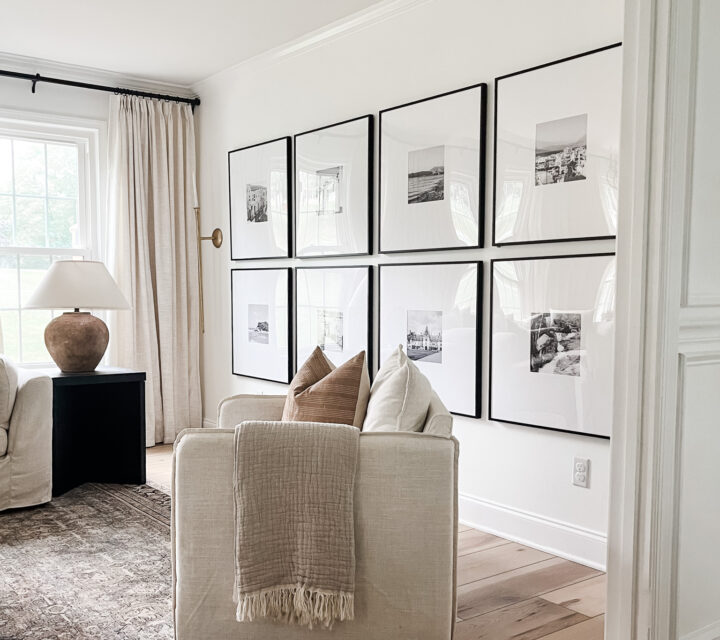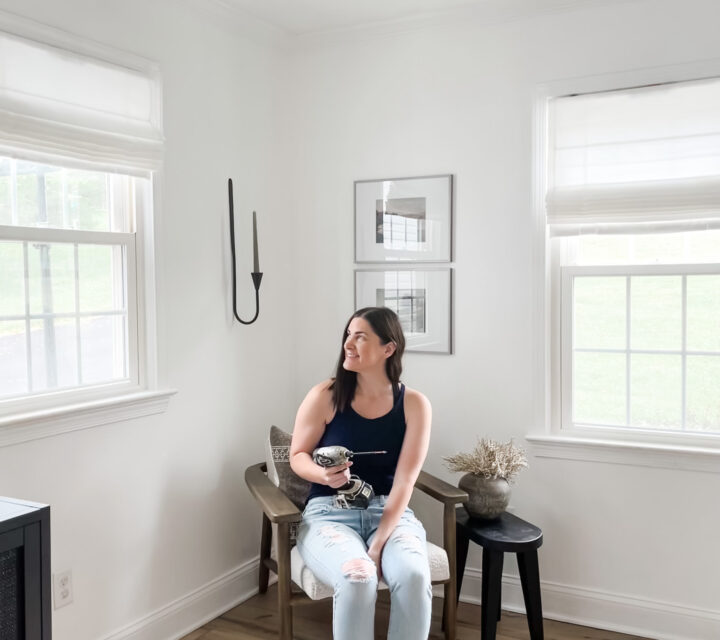Our big project this summer has been our deck makeover. We’ve been in our home nearly seven years now and we decided that this would be the summer we would finally fix our deck!
Our deck project has been a HUGE undertaking, as we had to completely rip out our old deck, add new decking, and then paint it all. We didn’t intend for the project to be this much work, and we certainly weren’t planning on ripping out our deck, but after we started working on it, we realized we were going to have to basically start from scratch with our deck.
Jason did all the heavy lifting, and he nailed it once again.
Can you believe he did ALL the demo himself and laid ALL the new decking himself?!? He also rebuilt part of the railing and extended our deck out near our staircase. More on that later.
He’s pretty much the greatest of all time, and he makes all my wildest dreams come true.
Here’s our new deck, in all her glory!!!

This post contains affiliate links. For more information, see my disclosure.
I’m so glad I took photos of the before because I had forgotten just how far we’d come with our deck.
Here’s a before photo of our deck:

I think the picture says 1,000 words. I don’t need to tell you how bad of shape our deck was in, but I will anyway.
The boards were in horrific shape! Not only was our deck dirty, it was collecting water on top of it when it rained. The paint that was on the boards had been sealed between each board, meaning there was nowhere for water to drain when it rained, so it just sat there on top of our deck.
Also, the type of paint that was used on the deck was textured, as you can see in the lower right hand corner. I believe this is a type of Behr deckover paint that you can get.
We really prefer a smooth surface, as we like to walk on our deck with our bare feet. This meant that we’d need to find a way to get the paint off and get the paint out of the cracks between the boards before we could repaint.
Plan A
The initial plan for renovating our deck was to sand off the current, textured paint and then repaint all the boards once they were smooth.
We rented a sander and tried to sand the deck. Here’s Jason hard at work.

Unfortunately, the sander only took up some of the textured paint and none of the painted gaps between the boards broke open.
Here’s a close up of where we tried to sand. You can see on the left side, some of the textured paint came up, while some of it didn’t.

We tried to think of other methods to use to get up the paint, but ultimately it would be difficult to get the paint out from between each board. That’s when we realized that this project was going to be A LOT more work than we had originally hoped and planned.
Plan B
At this point we realized that we’d have to start basically from scratch.
We decided that we would rip out the old boards and put new ones down. There wasn’t really any other option.
Fortunately, the foundation for the deck was already built and stayed (mostly) the same. In the upper left-hand corner below, you can see an area without railing. Jason ended up extending our current deck a couple feet to go in line with our staircase.
There was initially a bump out there for a grill, but since we put our grill in a different location, we didn’t need the bump out.
Jason left the rest of the foundation as it was.
Here’s what our deck looked like when Jason pulled up all the boards:

Woah!! I was sure he was going to find a snake or two, but luckily he didn’t!

Once we got all the new deck boards, Jason rebuilt the deck! He did an amazing job!!


Meanwhile, I worked on repainting all the railings. I used Cabot white stain on the railings, from Lowes. The reason I used this particular stain is because this was the original stain used on the railings and there was some leftover.

The only part of the railings that didn’t get white stain was the tops of the railings, which we used the same color as the floor deck boards: Boot hill gray. More on that below.
To stain or leave natural?
I shared our deck process as we did it over on Instagram, and I got lots of people saying to keep the natural wood decking instead of staining it.
Jason and I loved the natural decking as it was, but we had to stain it because we had several other areas that had the old deck color on it.
We have a couple sets of stairs that we did not replace with new boards. We were able to get the textured paint off those, so all we’d need to do is stain them to match our new deck.
We looked at a few different options for stain products and ultimately decided to go with Home Depot’s Waterproofing Stain & Sealer.
There are options to do transparent stain or solid stain, and again, we knew we’d have to choose a solid color so it would completely cover the old color of stain on the stairs.
Also, solid stain colors have a longer-lasting finish, so it worked out.
Since we did decide to go with a solid stain, the stain felt more like a paint than a stain to me. It applied just like paint would and felt just a tad thinner than paint.
How to stain the deck
Surprisingly, you cannot just go right in and stain a new deck. When new deck boards are installed, they have to remain in a natural state until they can absorb water. This usually takes at least several weeks up to a couple months.
We had to wait for weeks and weeks before we could do anything to our new deck.
Choosing a stain color
While we waited for our deck to dry out, we tested some sample colors on our landing, which is also made up of old deck boards.
It took us A LONG TIME to come up with the right paint color. Here are the samples we tried.

We really liked both the gray/brown colors on the left: Chatham fog and Boot hill gray. Ultimately, we decided to go with Boot Hill gray which was a tad darker, but still a light color overall.


There are specific instructions on the back of the stain can, which are always important to read.
The instructions said that we had to apply the paint in under 90 degree weather. We had to wait for a day that it wasn’t raining and that it wasn’t overly hot to apply the paint.
This was difficult because we had such a hot streak the past few weeks. Luckily there was an early morning that wasn’t too hot, so we woke up and applied the stain then.
This is how it looks when it’s first applied. It looks relatively dark here but it dries lighter.
*Note* – these photos below do not have a photo filter, as I want you to see the color as it actually looks.

We applied the stain much like we would paint. We used a roller first.


It looked good from the top angle, but from the side you could see the natural board.

We had to go back in and stain between each board with a paint brush.

I also filled stain in the nail hole areas, which took quite a long time!

After we were done, we waited for this to dry, and then we did a second coat with the roller.
Here’s what the final result looks like, after both coats of stain dried (this photo does not have a filter, so you can see the exact color):

We LOVE the results!
Here’s the before and after:


I can hardly get over the transformation!!!
Did I mention we have three other decks?!? We are in the process of completing the rest of our decks, and we hope to be done soon!




